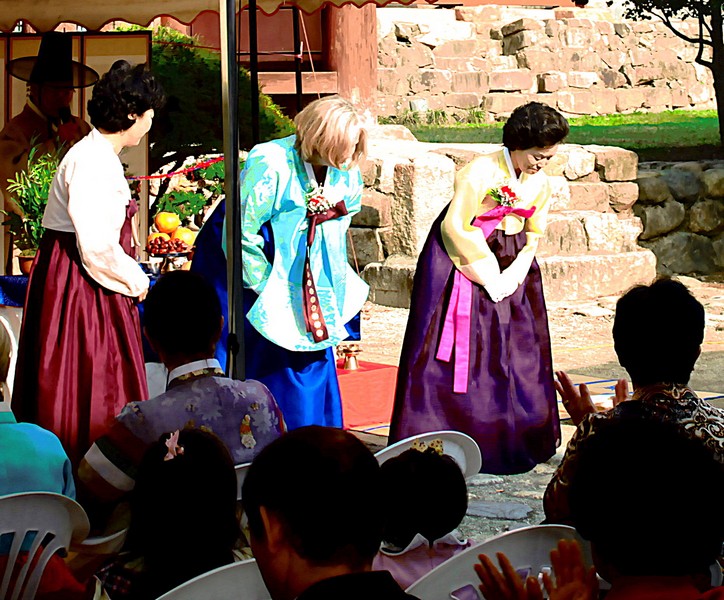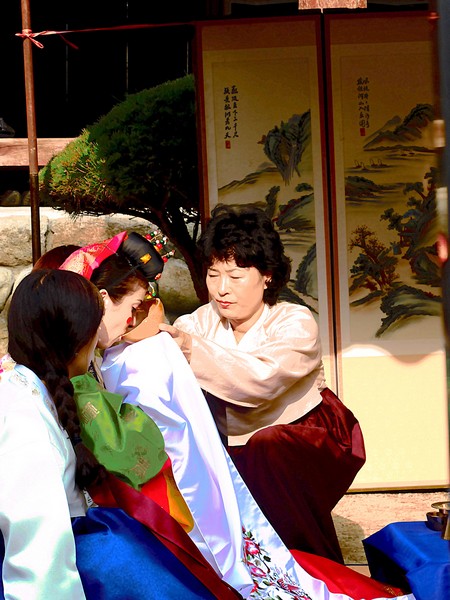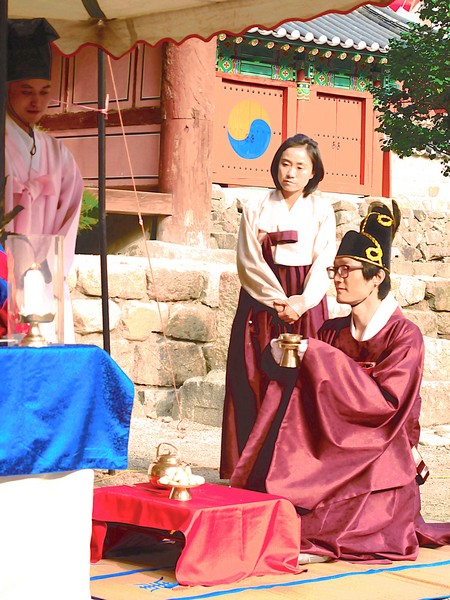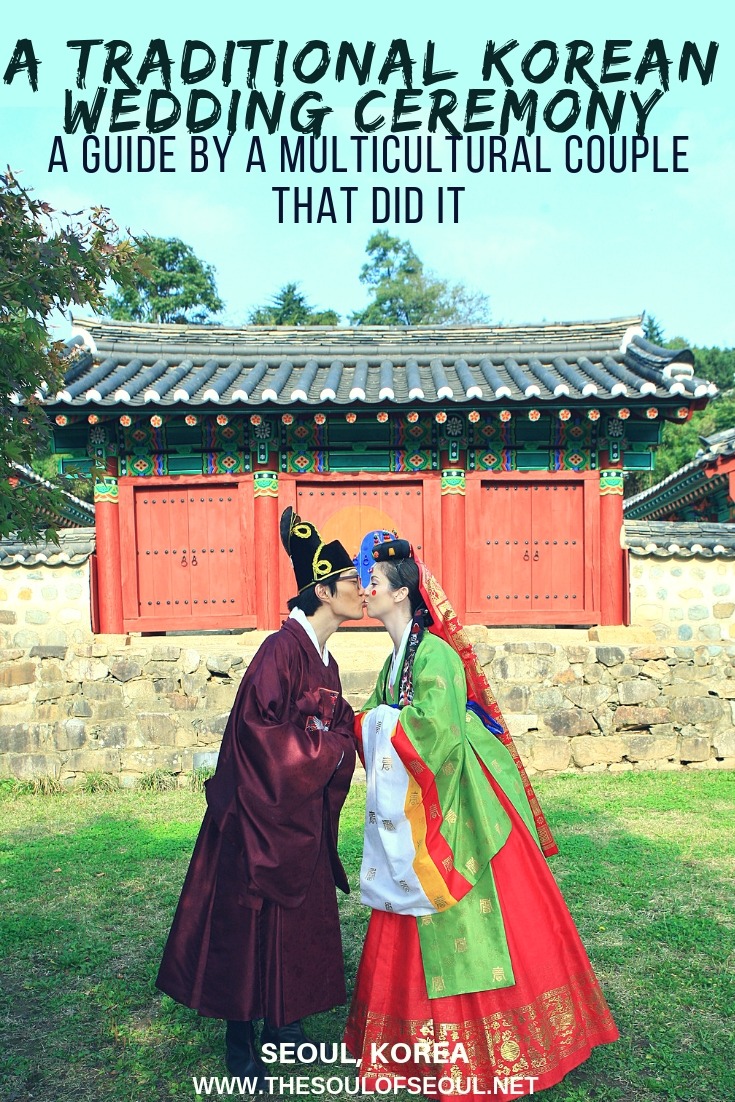A Guide To A Traditional Korean Wedding Ceremony By A Multicultural Couple That Did It
Getting married in another country or married to a person from another culture or country comes with a host of lessons and learning. When we decided to get married we very quickly decided we wanted to have a traditional wedding ceremony in each our home countries. So, with that, it was time to figure out how to plan a traditional Korean wedding ceremony. These days, many Koreans opt for a more western style wedding ceremony but since we were going to have that in the States where I’m from, we wanted to be traditional from beginning to end.

But, what happens in a traditional Korean wedding ceremony? I wondered. And, what does a traditional Korean wedding ceremony look like? I had never attended a traditional one though I’d been to quite a few weddings in Korea. What would we wear to the Korean wedding ceremony and what would my family need to do in the ceremony? Lots of questions abounded and then a lot of studying too.
Here is a guide to a Korean wedding ceremony, with some cute asides about our wedding. Whether you’re a multicultural couple like us or a Korean couple abroad or over Korean heritage looking to add elements of the traditional Korean wedding ceremony into your big day, this guide will help you.
- What To Wear To A Traditional Korean Wedding Ceremony
- Location Location Location
- The Steps In A Traditional Korean Wedding Ceremony
- What Is An Appropriate Gift For a Korean Wedding?
(This page contains affiliate links. That means if you click on them and purchase something, I will get a percentage at no cost to you. Thanks for the support!)
What To Wear To A Traditional Korean Wedding Ceremony
For a traditional Korean wedding ceremony, the bride and groom and the families as well as guests may/will opt to wear Hanboks, the traditional Korean dress. To learn more about the layers and how to put on a traditional wedding dress, check out this post because it goes into further detail about the dress itself and what the colors of the fabrics mean.
If you’re not in the wedding party though, it’s quite acceptable to wear a suit or nice dress.
Location Location Location
Traditionally the wedding ceremony would be held at the bride’s family home. There are vows and the bride and groom should seal their vows by sipping wine from a gourd that was grown by the bride’s mother. Today, most couples partake in the traditional wedding ceremony at various traditional sites around Korea. We got married down in Busan, my husband’s hometown in a beautiful site called Dongnae Hyanggyo 동례향고.
Did you know you can pretend to tie the knot in a traditional Korean ceremony here in Seoul? Check out this experience if you want to get dressed up in your own stunning Hanbok and walk through the ceremony.
The Steps In A Traditional Korean Wedding Ceremony
In Korean, a wedding ceremony is called a taerye or “the great ritual” and there are numerous steps involved.
The Pre-wedding Performance
There will be a samulnori, or a traditional performance that includes a percussion quartet which includes the kkwaenggwari (a small gong) which represents “thunder”, the jing (a larger gong) which represents wind, the janggu (an hourglass shaped drum) which represents rain, and the buk (a barrel drum) which represents clouds. There is also a buchaechum, or a traditional fan dance performed.
If you want to see what the traditional dances and samulnori are like, check out one of the traditional performances around Seoul. The National Gugak Center hosts a Saturday performance each week to showcase the folk arts and culture. Korea House has one of the best performances and you can also choose to have a 5 course award winning Joseon Dynasty style meal served too. Don’t miss that but if you want something a bit more contemporary yet with a traditional twist definitely look into the Sun and Moon Traditional Korean music show
Our ceremony started ten minutes earlier than we’d put on our invitations and even though I tried to feign misunderstanding and go for a wander so my friends could make it in time the attendants got the mothers up to begin. I don’t really know what time everything got under way as I had no watch to look at, and even if I did the sleeves on my wedding Hanbok were two feet longer than my arms so I couldn’t check all that easily. But so it began and so did we…

Step 1: The Jum-chok Rye
To begin the ceremony my mother along with Jae-oo’s mother performed the Jum-chok Rye. They lit candles to invoke the god of heaven to be present at the ceremony by sending up candle flames. Jae-oo’s mother lit a red candle and my mother lit a blue candle. They ended by bowing toward each other and then toward the guests. I told my mom before they went up, who wasn’t sure how low to bow or for how long to keep one eye on Jae-oo’s mom the whole time so they’d get it right. It seemed to work out well.
Step 2: Young-seo Rye
Next was Jae-oo’s entrance, or Young-seo Rye. The groom enters with his attendant (the girukabi), who is carrying a goose. Usually the bride’s father would meet the groom at the front gate, but as my own has already passed away Jae-oo just entered with his attendant.
Step 3: The Jeon-an Rye
Once they got to the front they would perform Jeon-an Rye, which would be the handing over of the goose from the groom to my father. They requested that my mother accept the goose instead.
The wild goose symbolizes that this couple will model after the three virtues of wild geese. First, wild geese keep the promise of love forever. If a wild goose loses its mate it lives alone and never seeks another mate. Second, wild geese follow the hierarchical order. When they fly, they fly in the V formation. If the leader cries, the rest cry in response. And third, wild geese leave traces when they come.
Jae-oo had to take the goose and ensure that its head was facing left, my mother was positioned to stand to face the west and then Jae-oo had to kneel toward the north. The goose was placed on the table with its head still facing west and after Jae-oo bowed to floor twice my mother took the table with the goose back to wear my family was seated.
Step 4: The Chin-young Rye
I walked down the aisle during the Chin-young Rye to take my position on the west with Jae-oo on the east side of the table.

Step 5: Kyo-bae Rye
We washed our hands to symbolize that we purify our minds and body before the sacred ceremony in Kwan-sae Rye. We each had helpers to move things around as in the magnificent Hanbok there was no way we can do it all ourselves. The assistants helped to move me into position on a mat. I had to keep my arms up with the long cloth covering my upper chest though traditionally I read that the bride should be covering her face.


Step 6: Kwan-sae Rye
This portion of the ceremony was something I’d been joking about for weeks. I was to bow 6 times deeply to the floor while Jae-oo was only going to bow twice. I’m all for fairness and though we should just split it in half, four and four. We’re equal partners after all. Though according to that goose at the beginning I’m probably below Jae-oo in the hierarchy so 6 bows it was.
We were to bow to each other to pay homage to our union as a couple and pledge our respect for each other throughout our lives. I bowed twice, followed by once from the groom, twice more from me, once more from him, and rounded it out with two more from me. I had two attendants helping me so it wasn’t difficult at all and with the multiple layers of Hanbok on no one could see how I was getting up or down. But it was smooth and I got claps after my first go by those apparently surprised by my bowing technique.



Step 7: Hap-geun Rye
The rest of the ceremony was a lot of drinking and eating. With the Seo-cheon-ji Rye we pledged to the gods of heaven and earth that we would fulfill our obligations as husband and wife. We raised our cup of wine to the sky and then poured it out, and then filled it again to pour on the ground and then we put some of the food on the table. We filled up the cups again in the Seo-bae-woo Rye and this time pledged to each other and then drank from the cups.
And finally in Keun-bae Rye a gourd that had been split in two was filled with wine, we exchanged our halves and drank from them. This ritual declared us as becoming one body and one mind. When a gourd is split in half each half has only one other half in the world and these two unite together to form the whole.


Step 8: Seong-hon Rye
And finally we bow to our families and guests to thank them for coming and to declare our marriage.

Post Wedding Ceremony Ceremony
This ends the wedding ceremony though not the whole ceremony as next was paebeck. The paebaek ceremony is only for family members and there are more bows as well as some fun games like a piggy back ride to try. For that, click on the link above to get more information. And now that you’re getting married, you should probably know about the other traditional Korean ceremonies like the dol, or your baby’s first birthday celebration in Korea.
What Is An Appropriate Gift For a Korean Wedding?
Koreans generally don’t give gifts but instead opt to give money. Usually at the entrance to a wedding ceremony, whether it be traditional or modern, there are two tables, one for the bride’s friends and family and one for the groom’s friends and family. At these tables, the envelopes are collected and your name is written into the registry. Once you give your money gift, this is also usually when you receive your “ticket” for the reception. Basically, you’re paying for your seat. All of the money collected here goes to the parents to pay off the wedding.

Money is usually given in odd numbers anywhere between $30 up to $100 depending on how close you are with the person or persons. Koreans invite anyone and everyone to their weddings, or I should say Korean parents invite anyone and everyone so if you’ve only just met someone and are invited, you can give $30 and feel comfortable about that. If you work together and talk every day, $50 might be more suitable and if you’re besties then $100 is lovely. If you’re really close though, you probably won’t give your gift at the table out front though as all close friends know to give gifts directly to the couple if they want the couple to ever see them.
Funnily enough, at my wedding, my western friends came with nice cards as one would expect and handed them in to the registry table. I never saw the cards because my in-laws removed the money and trashed the cards… I only found out later from one of my friends. So, lesson here, if you want your gift to go directly to the couple, give it directly to the couple.
Did you like this post? Pin It!


